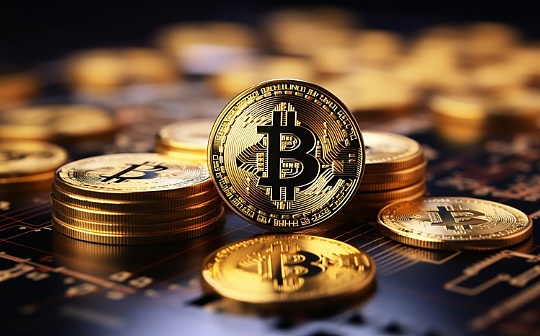
Author: CryptoVizArt, UkuriaOC, Glassnode; Compilation: Wuzhu, bitchain vision
summary
-
Bitcoin has recovered its short-term holder cost base ($61,900) and 200DMA ($63,900) after the Fed cut rate by 0.50%.
-
After a period of net capital outflow, the pressure faced by short-term holders has eased slightly as prices rise above the cost basis.
-
New investors show some degree of resilience and relatively small actual losses, indicating that they are confident in the overall uptrend.
-
The perpetual futures market showed a cautious resurgence, with demand gradually increasing, but still below the level during the strong bull market.
The transformation of market gradient
After the market reached its March ATH, capital flows into the Bitcoin network slowed down, causing price momentum to weaken.This can be confirmed by comparing the smooth 155-day gradient of the price (black) with the actual price (red).
In recent weeks, the market gradient has dropped to negative values, while the actual price gradient is positive, but the trend is low.This shows that the decline in spot prices is greater than the intensity of capital outflows.
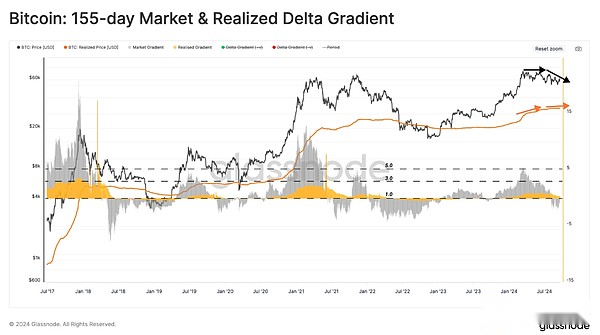
The figure below measures the z-fraction of these two gradients.Negative values can be explained as periods of relatively weak demand, resulting in continuous contraction of prices.
Using this metric,We can see that the current structure is very similar to the 2019-20 period, with the market going through a longer period of consolidation following a strong rebound in the second quarter of 2019.
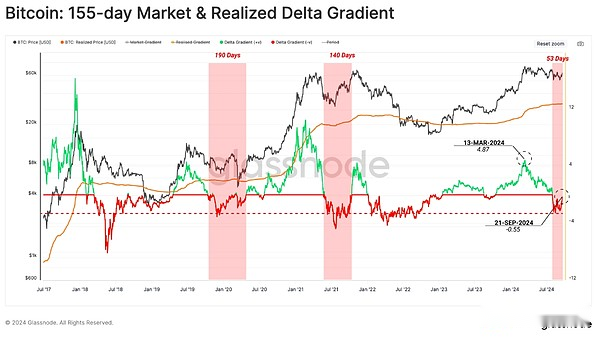
New capital flow
Since late June 2024, the current consolidation phase has pushed spot prices below the cost base of several short-term holder subgroups (MVRV ratio <1).This highlights how investors are under financial pressure in recent times and are suffering from increasing unrealized losses.
However,Although many new investors have negative holdings, their unrealized losses are significantly lower than the mid-2021 sell-off and the COVID crash in March 2020.
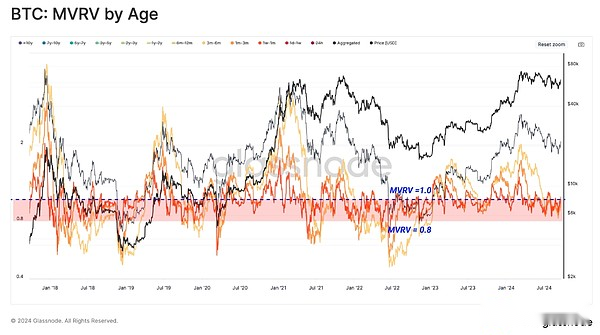
When the market enters a long-term contraction, diminishing returns will prompt investors to cash out at a lower price to reduce losses.Therefore, the relatively young supply cost basis will be lower than the spot price.Short-term holder supply is repriced to a lower price, which can be described as a net capital outflow of the Bitcoin ecosystem.
To measure the direction and intensity of capital flows from the perspective of new investors, we constructed an indicator to compare the cost basis of the two subgroups (1w-1m as the fast trajectory and 1m-3m as the slow trajectory).
-
Capital Outflow (Blue) In the market downward trend, the cost basis of the youngest token (1w-1m red) is lowered faster than that of the older age group (1m-3m red).This structure indicates that the overall direction of capital flows is negative, and the intensity of this outflow is proportional to the deviation between these trajectories.
-
Capital inflows (blue) In the upward trend of the market, the cost basis of younger tokens expands faster than that of the old coin age group.This suggests that the rate of capital inflows is proportional to the divergence between these trajectories.
The cost base of newer tokens is currently lower than that of older tokens, indicating that the market is experiencing a net outflow mechanism.Using this indicator,Sustainable market reversals may be in the early stages of forming a positive momentum.
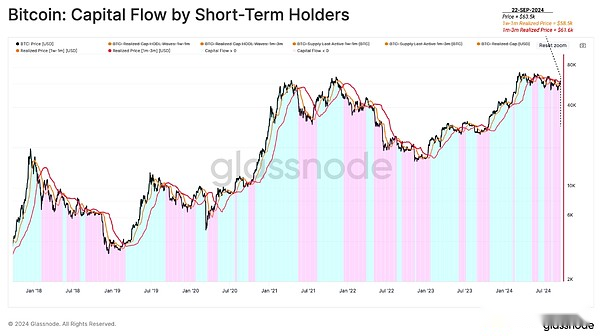
New investors’ confidence
As new investors’ unrealized losses held by them during market adjustments increase, so does their tendency to surrender when they lose.Statistics show thatShort-term holders are more sensitive to volatility, which makes their behavior help track market inflection points.
When checked with MVRVs by age, the SOPR indicators by age show almost the same behavior.This confirms that new investors are both in a loss-making state and under pressure to concrete these losses.

We can also evaluate the intensity of short-term holders’ response to changes in market sentiment.
The difference between the cost basis of new investors who are consuming (red) and the cost basis of all new investors (blue) reflects their overall confidence.When standardized through spot prices, this bias allows us to highlight periods in which new investors overreact to extremely high unrealized profits or losses.
New investors who have purchased tokens in the past 155 days have shown higher market confidence than the previous “bearish trend.”Compared to the cost basis they hold, the loss of this group of people locked in is still relatively low.

Long perpetual contract premium
We can use the perpetual contract futures market to add another dimension to our survey of New Capital confidence in the upward trend.First, we use futures perpetual contract financing rates (7D-MA) to show that speculators are willing to pay higher rates to take on leverage on long positions.
Considering that the 0.01% financing rate value is the equilibrium value of many exchanges, we consider deviations above this level as the threshold for bullish sentiment.The recent price rebound is accompanied by the relative heat upward trend in the perpetual contract market for bulls to leverage.This has pushed the weekly average financing rate to 0.05%.
Although this is above the equilibrium level,It is not yet possible to indicate that the degree of long-biased demand in the perpetual contract market is strong or excessive.

If we calculate the cumulative monthly premium paid by long contracts to shorts over the past 30 days, we can see that the total cost of leverage near ATH in March is about $120 million per month.
As of mid-September, the indicator had plummeted to $1.7 million a month and has now risen slightly to $10.8 million a month.As a result, demand for long leverage has increased over the past two weeks, but is still well below the January 2023 level.This indicates that the market has cooled significantly during this adjustment period.
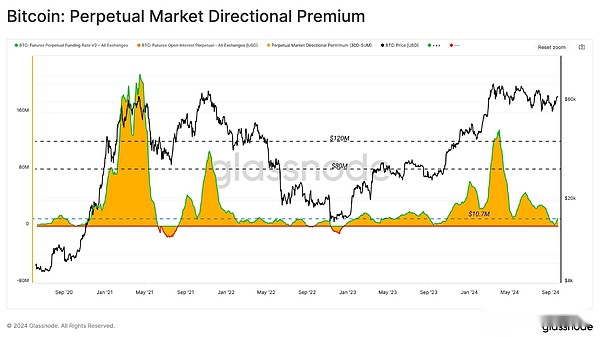
Summarize
The Bitcoin market has been in a long consolidation phase, which is reminiscent of the period from the end of 2019 to the beginning of 2020.Capital inflows to the Bitcoin network have slowed since its record high in March, challenging the profitability of short-term holders.
However, despite a period of local net capital outflow, new investors’ confidence in the market remains very strong.In recent weeks, long preferences in the perpetual futures market have also seen a very moderate increase.
Overall, this paints a picture of a market cooling off from the excessive volatility in March, while not breaking the sentiment of many new Bitcoin investors.








